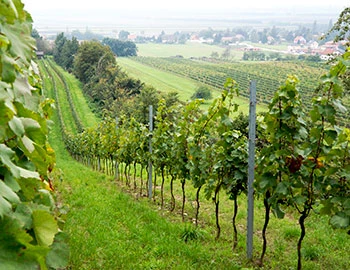Jumilla
Jumilla: The home of Monastrell
Discoveries of grape seeds dating to the third millennium BCE indicate that Jumilla is among the oldest viticultural regions in the Iberian Peninsula. Today, more than 80 percent of the total cultivation area of 25,000 hectares is planted with the long-established Monastrell variety. Thanks to moderate watering, a tendency for early harvesting and modern cellar techniques, Monastrell wines produced here today have a great deal of fruit-accented charm and good structure.
Red wines from Jumilla
Sweet wines from Jumilla
The red Monastrell variety, known in France as Mourvèdre, is particularly comfortable in areas that other varieties would find much too hot. It also makes do with minimal amounts of water. A semi-arid savannah climate prevails in the Jumilla wine region, meaning that more water is lost in the summer months than is gained through rainfall. With annual rainfall of only 260 millimeters per year per square metre, the region is among the driest viticultural regions in Europe. Moreover, this meagre amount of rain falls almost exclusively in spring and autumn.
More elegant wines, thanks to irrigation
Nonetheless, the vines, which are traditionally trained here in bush form (gobelet), grew without artificial irrigation until 20 years ago. Through this “dry farming”, the grapes remained small, with a corresponding proportion of skin, yielding enormously concentrated wines with plenty of tannin.
New grounds, where the vines now grow via cables (guyot) and are equipped with drip irrigation systems, provide for lower-alcohol, more elegant wines whose fresh dark fruit aromas and beautiful spice correspond better to modern consumers’ tastes. However, such irrigation systems exacerbate the general scarcity of water in the Spanish Levant.
True-rooted vines
But the best and most distinctive wines of the region still come from very old Monastrell vines that grow ungrafted, or true-rooted, in barren limestone soil. These vines, called “Pie Franco”, yield highly concentrated wines with excellent tannin structure yet no shortage of elegance and freshness.
Assemblages are trending
Many premium wines from Jumilla are varietal Monastrell crus, which mature in barriques made of French and American oak. In recent years, however, high-quality assemblages have also come onto the market. These are based on Monastrell but complemented with Cabernet Sauvignon, Merlot or Syrah. The Jumilla designation of origin, introduced in 1966, is one of the oldest in Spain. The cultivation area features a continental climate with Mediterranean influences. Its brown soils are very rich in lime and poor in organic matter.








